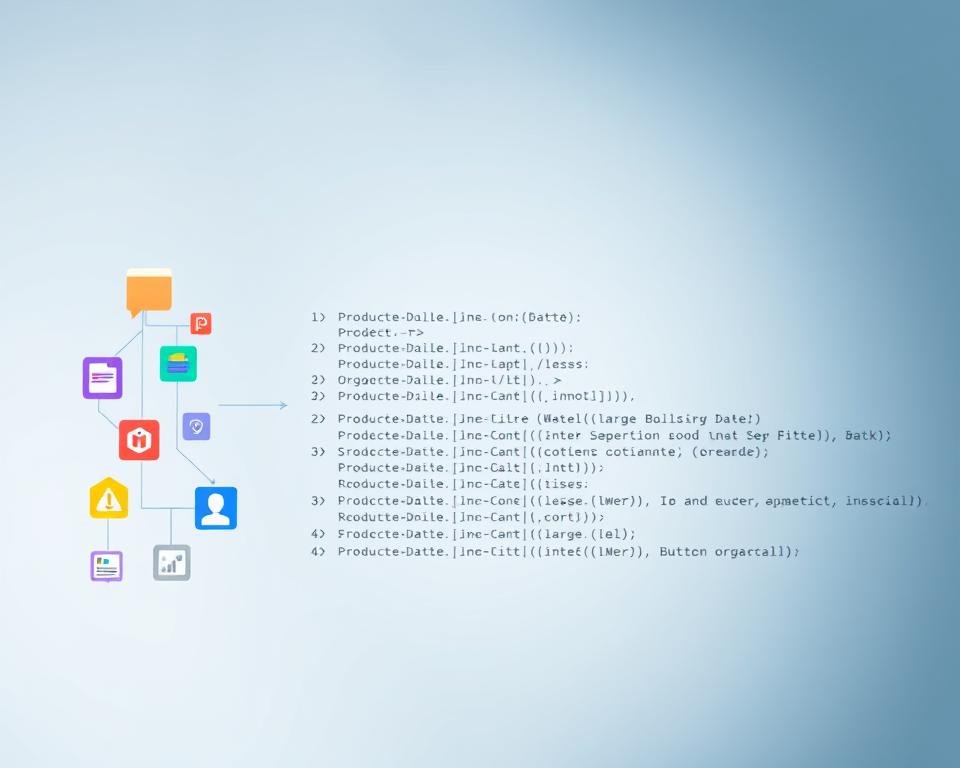I begin to explain technical search engine optimization by highlighting its crucial role in digital marketing. Optimizing a website for search engines to crawl, index, and rank properly is essential for improving online visibility.
Technical SEO is vital for driving more traffic and increasing online presence. As I delve into the details, it becomes clear that a well-optimized website is better equipped to handle the demands of search engine algorithms.
Key Takeaways
- Technical SEO is crucial for digital marketing success.
- Optimizing a website improves its online visibility.
- A well-optimized website drives more traffic.
- Technical SEO increases online presence.
- Search engine algorithms favor optimized websites.
Understanding Technical SEO
The technical SEO landscape is complex, but understanding its fundamentals is key to driving traffic and boosting online presence. As I delve into the world of technical SEO, it’s clear that its impact on digital marketing is multifaceted.
Definition of Technical SEO
Technical SEO refers to the process of optimizing a website’s technical aspects to improve its search engine ranking. This involves a range of strategies, including optimizing site speed, ensuring mobile responsiveness, and creating XML sitemaps. Effective technical SEO is crucial for enhancing a website’s visibility and driving organic traffic.
The core of technical SEO is about making a website technically sound, so search engines can crawl, index, and rank it higher. This includes aspects like website architecture, URL structure, and the use of structured data.
Importance in Digital Marketing
The importance of technical SEO in digital marketing cannot be overstated. By implementing robust technical SEO strategies, businesses can significantly enhance their online presence. Here are some key reasons why technical SEO is vital:
- Improved site speed enhances user experience and search engine rankings.
- Mobile optimization is crucial for reaching a wider audience.
- Proper indexing ensures that search engines can find and rank a website’s pages.
By focusing on these technical aspects, businesses can drive more traffic to their websites and stay ahead in the competitive digital landscape. Technical SEO strategies are not just about search engine rankings; they’re about creating a seamless user experience that fosters engagement and conversion.
Key Components of Technical SEO
The foundation of a successful SEO strategy lies in its key components, which include website architecture, URL structure, and XML sitemaps. These elements work together to ensure that a website is crawlable, indexable, and visible to search engines.
Website Architecture
A well-structured website architecture is crucial for both user experience and search engine optimization. It helps search engines understand the site’s content hierarchy and organization.
Key aspects of website architecture include:
- Clear categorization and organization of content
- Logical internal linking
- Avoiding deep nesting of pages
URL Structure
A clear and concise URL structure is vital for both users and search engines. It aids in understanding the site’s content and hierarchy.
Best practices for URL structure include:
- Using descriptive and concise URLs
- Avoiding unnecessary parameters and characters
- Including target keywords where relevant
XML Sitemaps
XML sitemaps play a critical role in helping search engines discover and crawl a website’s pages. They are especially useful for large sites or sites with complex structures.
| Benefits of XML Sitemaps | Description |
|---|---|
| Improved Crawling | Helps search engines discover new and updated content |
| Enhanced Indexing | Aids in the proper indexing of website pages |
| Better Visibility | Increases the visibility of a website’s content in search results |
Mobile Optimization in Technical SEO
As mobile internet usage continues to grow, the importance of mobile optimization in technical SEO cannot be overstated. With the majority of internet users accessing websites through mobile devices, ensuring a seamless mobile experience is crucial for both user engagement and search engine rankings.
Mobile optimization involves several key aspects, with responsive design being one of the most critical. A responsive design ensures that a website adapts to different screen sizes, providing an optimal viewing experience across various devices.
Responsive Design
A responsive design is not just about aesthetics; it significantly impacts user experience and, consequently, search engine optimization (SEO). By implementing a responsive design, websites can improve user engagement, reduce bounce rates, and enhance overall Technical SEO implementation.
Some key benefits of responsive design include:
- Improved user experience across devices
- Reduced bounce rates due to easier navigation
- Simplified content management with a single version of the website

Mobile Page Speed
Another vital aspect of mobile optimization is page speed. Mobile page speed refers to how quickly a website loads on mobile devices. Slow-loading websites can lead to high bounce rates and decreased search engine rankings, making it essential to optimize images, leverage browser caching, and minimize code to improve loading times.
Utilizing Technical SEO tools can help identify areas for improvement in mobile page speed. Tools like Google PageSpeed Insights provide detailed recommendations for enhancing website performance on mobile devices.
By focusing on both responsive design and mobile page speed, businesses can significantly enhance their technical SEO, leading to better search engine rankings and improved user engagement.
Importance of Site Speed
In the realm of technical SEO, site speed is a vital component that influences how users interact with a website and how search engines rank it. A fast-loading website can significantly enhance user experience, leading to higher engagement rates and lower bounce rates.
Factors Affecting Site Speed
Several factors can impact a website’s loading speed. These include:
- Image sizes: Large images can slow down a website. Optimizing images by compressing them or using appropriate formats like WebP can help.
- Coding quality: Poorly written code can lead to slower load times. Minifying CSS and JavaScript files, and avoiding too much inline code, can improve site speed.
- Server response times: The time it takes for a server to respond to a user’s request can significantly affect site speed. Using a reliable hosting service and leveraging browser caching can reduce server response times.

Tools for Measuring Site Speed
To improve site speed, it’s crucial to first measure it. Several tools can help:
- Google PageSpeed Insights: This tool analyzes a website’s content and provides suggestions for improvement.
- GTmetrix: Offers detailed insights into a website’s performance, including page load time, page size, and the number of requests.
- Pingdom: Tests a website’s load speed and provides performance grades and recommendations.
By understanding and addressing the factors that affect site speed, and utilizing the right tools, website owners can significantly enhance their site’s performance, thereby improving user experience and search engine rankings.
Secure Sockets Layer (SSL)
In the realm of Technical SEO, having a Secure Sockets Layer (SSL) certificate is no longer a luxury, but a necessity for safeguarding user data and improving search engine rankings.
As I explore the concept of SSL, it becomes clear that it is a critical component of Technical search engine optimization. SSL certificates encrypt data transmitted between a website and its users, protecting sensitive information and building trust with visitors.
What is SSL?
SSL, or Secure Sockets Layer, is a security protocol that creates an encrypted connection between a website and a user’s browser. This encryption ensures that any data exchanged between the website and the user remains confidential and secure.
Key aspects of SSL include:
- Encryption of data to prevent unauthorized access
- Authentication of the website’s identity to prevent impersonation
- Ensuring the integrity of data to prevent tampering
Benefits of Using SSL
The benefits of using SSL are multifaceted and significantly impact a website’s Technical SEO. Some of the key advantages include:
Improved Security: SSL encrypts data, protecting it from interception and eavesdropping.
Enhanced Trust: Websites with SSL certificates display a padlock icon in the address bar, indicating to users that the site is secure and trustworthy.
SEO Benefits: Google considers SSL a ranking factor, making it essential for websites to have an SSL certificate to improve their search engine ranking.

Crawling and Indexing
Search engines use crawling and indexing to discover, analyze, and rank websites, making these processes vital for Technical SEO best practices. Understanding how these processes work is crucial for optimizing a website’s visibility in search engine results.
How Search Engines Crawl
Search engines crawl websites by using software programs called crawlers or spiders. These crawlers navigate through the web by following links from one page to another, discovering new and updated content along the way.
The crawling process involves several key steps:
- Discovering new URLs through sitemaps or links from other pages.
- Following redirects and resolving canonical URLs.
- Analyzing the content of the page to understand its relevance and context.

Why Indexing Matters
After a page is crawled, it is indexed by the search engine. Indexing involves storing and organizing the content of the page in massive databases called indexes. This allows the search engine to quickly retrieve and display relevant results when a user performs a search.
Indexing matters because it determines whether a page can appear in search engine results. Without proper indexing, a page may not be visible, regardless of its relevance to the search query.
To ensure effective indexing, it’s essential to implement Technical SEO strategies such as optimizing meta tags, using clear and descriptive URLs, and avoiding duplicate content.
Handling Crawl Errors
Crawl errors occur when a search engine crawler is unable to access or properly crawl a webpage. These errors can be caused by a variety of issues, including server errors, DNS resolution failures, or blocked URLs in robots.txt.
To handle crawl errors effectively, website owners should:
- Monitor crawl errors using tools like Google Search Console.
- Identify and fix the root cause of the errors, such as fixing broken links or resolving server issues.
- Regularly update sitemaps to ensure that new and updated content is discoverable.
By understanding and addressing crawl errors, website owners can improve their site’s crawlability and overall search engine ranking.
Structured Data and Schema Markup
Technical SEO audit often highlights the importance of structured data and schema markup in improving a website’s search engine ranking. As I explore the world of technical SEO, it becomes clear that these elements are crucial for providing search engines with additional context about a website’s content.
What is Structured Data?
Structured data refers to the standardized format used to provide search engines with information about a webpage’s content. It helps search engines understand the context and meaning of the content, enabling them to display rich snippets in search results. Rich snippets are enhanced search results that provide users with more information about a webpage, making it more likely for them to click on it.
Some common types of structured data include:
- Event schema
- Review schema
- Recipe schema
- Business schema
Benefits of Schema Markup
Schema markup is a type of structured data that provides search engines with additional information about a webpage’s content. The benefits of schema markup include:
- Improved search engine rankings: By providing search engines with more context about a webpage’s content, schema markup can improve its ranking in search results.
- Enhanced search results: Schema markup enables search engines to display rich snippets in search results, making it more likely for users to click on the webpage.
- Increased click-through rates: Rich snippets can increase click-through rates by providing users with more information about a webpage’s content.

In conclusion, structured data and schema markup are essential components of technical SEO that can improve a website’s search engine ranking and visibility. By providing search engines with additional context about a webpage’s content, schema markup can enable search engines to display rich snippets in search results, making it more likely for users to click on the webpage.
Duplicate Content Issues
Understanding and addressing duplicate content is crucial for effective Technical SEO implementation. Duplicate content can confuse search engines and dilute a website’s ranking, making it essential to identify and resolve such issues.
Causes of Duplicate Content
Duplicate content can arise from various sources, including content scraping, printer-friendly versions of pages, and duplicate meta tags. It’s crucial to identify these causes to implement the right solutions.
Some common causes include:
- Content scraping by other websites
- Printer-friendly or mobile versions of pages
- Duplicate meta tags or titles
- Session IDs or URL parameters that create multiple versions of the same page
How to Resolve Duplicate Content
Resolving duplicate content involves several strategies, including the use of canonical URLs, meta tags, and 301 redirects. Implementing these techniques can help mitigate the issues caused by duplicate content.
Here are some effective methods to resolve duplicate content:
| Method | Description | Benefits |
|---|---|---|
| Canonical URLs | Specify the preferred version of a page | Helps search engines understand the primary content |
| Meta Tags (Robots) | Use “noindex” to prevent indexing of duplicate pages | Prevents dilution of ranking by duplicate content |
| 301 Redirects | Redirect duplicate pages to the primary version | Consolidates ranking signals to the main page |
By understanding the causes of duplicate content and implementing these resolution strategies, website owners can improve their site’s visibility and search engine ranking.

HTTPS vs. HTTP
With the increasing importance of online security, HTTPS has emerged as a critical component of technical SEO. As a website owner, understanding the differences between HTTPS and HTTP is crucial for maintaining a secure online presence and ensuring search engine rankings.
The primary distinction between HTTPS and HTTP lies in the level of security provided. HTTP, or Hypertext Transfer Protocol, is the foundation of data communication on the web, but it is not secure. HTTPS, on the other hand, adds an extra layer of security by using SSL/TLS encryption to protect data exchanged between a website and its users.
Differences between HTTPS and HTTP
The main differences between HTTPS and HTTP can be summarized as follows:
| Feature | HTTP | HTTPS |
|---|---|---|
| Security | Not secure, data is transmitted in plain text | Secure, data is encrypted using SSL/TLS |
| SEO Impact | May be penalized by search engines for lack of security | Preferred by search engines, considered a ranking factor |
| User Trust | Users may see warnings about the site not being secure | Users are more likely to trust the site, seeing it as secure |
Why HTTPS is Essential
HTTPS is essential for several reasons. Firstly, it ensures that data exchanged between a website and its users remains confidential and secure. Secondly, Google considers HTTPS a ranking factor, meaning that websites using HTTPS are more likely to rank higher in search engine results. Lastly, HTTPS helps build trust with users, as most modern browsers indicate whether a site is secure or not.
Key benefits of HTTPS include:
- Improved security through encryption
- Better search engine rankings due to Google’s preference for HTTPS sites
- Increased user trust, as indicated by the “lock” icon in browsers
To illustrate the importance of HTTPS, consider the following image:

In conclusion, transitioning from HTTP to HTTPS is a vital step in enhancing website security and improving search engine rankings. By understanding the differences between HTTPS and HTTP, website owners can make informed decisions to protect their users and maintain a competitive edge online.
Technical SEO Best Practices
To stay ahead in search engine rankings, it’s essential to follow technical SEO best practices. Technical search engine optimization plays a crucial role in improving website visibility and driving organic traffic.
Conducting Regular Audits
Regular audits help identify technical issues, such as crawl errors, duplicate content, and slow page speed. By addressing these issues, website owners can improve their website’s overall performance and search engine rankings.
The Importance of Staying Up-to-Date
The importance of technical SEO lies in its ability to adapt to the ever-changing search engine algorithms. Staying informed about the latest SEO trends and updates enables website owners to adjust their strategies and maintain their search engine rankings.
Staying Informed on SEO Trends
Technical SEO best practices involve staying informed about the latest developments in search engine optimization. By doing so, website owners can refine their strategies and improve their website’s visibility in search engine results.
